Yankee Elv and I went to Reverse Garbage today to kick-start our Christmas shopping. As always, the place inspired me, so I came home and wrote a review.
Check it (the review) out!

Yankee Elv and I went to Reverse Garbage today to kick-start our Christmas shopping. As always, the place inspired me, so I came home and wrote a review.
Check it (the review) out!
Ever thought of using denim jeans for building insulation? These folks have.
Typically, insulation is made from fibreglass. Fibreglass is exactly what is sounds like – tiny glass fibres. In an earlier post I discussed (at a high level) manfacture of glass. It’s not fabulous for the environment (although better than plastic in my opinion). I would definitely say blue jeans are better. They’re better for people and the environment. I like that the jeans are either old ones that would otherwise be discarded, or denim off-cuts from denim manufacturers. Considering cotton (which denim is made of) is such a water-intensive crop, however, is the best choice for the environment though?
If it was up to me, I’d go strawbale. The straw is just leftovers from grain crops, cheap, easy to construct and very effective.
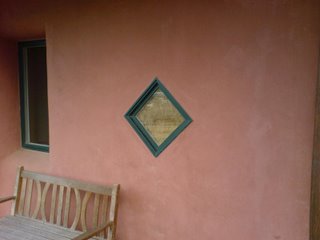
An exterior truth window on a strawbale house, showing the straw inside. Photo from Paso Straw Bale Construction Blog.
Besides, strawbale* is pretty. I like it.
I wonder if the federal government would provide a rebate on building a strawbale house, under their insualtion scheme? Somehow, I doubt it. Hmm.
*Photo from Paso Straw Bale Construction Blog.
Good news on the bottled water front – bottled water sales are on their way down! Check out these articles, from Consumerist and Twilight Earth for more info. I think it’s probably partially due to the recession, but if folks get used to not buying it, then it will be much easier to convince them not to start up again when the money starts flowing once more. Kinda like how even though the drought is over in Brisbane now, everyone still uses water saving devices and I haven’t seen anyone hosing their garden or washing their cars. We all just got used to it.
In case you don’t know why bottled water is bad for the environment, here are the key points:
You can find out more at the Bottled Water Alliance. They have some interesting facts there. I didn’t know, for example, that restaurants are required by law to provide you with tap water if requested (you can’t be forced to buy a bottle if you want some water).
Other folks have already jumped on the bandwagon too – No Impact Man, for example, who has pledged to Break the Bottled Water Habit and uses a glass jar as his water bottle. I’m not really into using a jar (although kudos to him) – the mouth is too wide and I’d spill it down my face, and if I got a narrower one, it would bump my nose. Yes, I’m a bit un-co. My buddy, Dyke Mike, is looking at buying a stainless steel water bottle to use and refill.
In the effort to create less waste and buy less stuff if I already have something I could reuse, I am using glass juice or iced tea bottles (that I had already saved) to contain my water.
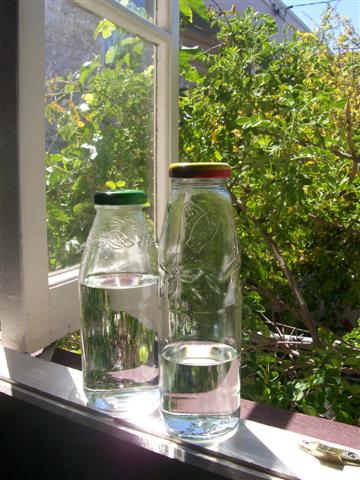
Two glass bottles, sitting on a sill...
I am running into a problem with the insides of the metal lids rusting, so if anyone has ideas on how to combat that, let me know. I really need to use some kind of bottle with a lid when I’m out, but also by my bed or out on the verandah, cos I am super clumsy and knock things over. When I’m at work, I just refill my big glass (heavy-bottomed so it doesn’t tip if I bump it!) a lot. More water bubblers around the city and on the bikeway are good too – I have scoped out a few, if I need an emergency water fix whilst out shopping or walking home from work.
I’m definitely all about avoiding the plastic right now, but as a decidedly not-wealthy person, I never liked the idea of paying for what I can get for free! So I know that my purchases aren’t really making an impact on this drop in sales… but I’m glad sales are dropping nonetheless.
I read this interesting article about how breastfeeding is the greenest choice. Of course, I agree – and when (some years down the line), Yankee Elv and I have more kids, we’ll try to share breastfeeding of the babies. There are herbs and medications you can take to induce lactation even if you’re not the birth mother, and just a small amount of breastmilk each day can significantly increase the child’s immunity. It’s the best choice, although naturally not the only choice.
What if you can’t breastfeed though – what then? Yankee Elv couldn’t with Mr Teeny-bop, so he was bottle-fed and grew up just fine. It’s not as eco-friendly as the breast though. So is there a way to make bottle-feeding greener?
I know this doesn’t really impact me at this point in time, but I find it interesting nonetheless!
Question. Is it better to buy a smaller glass container or a larger plastic container?
Answer? I don’t bloody know! I can’t decide. Help!
We buy Bertolli olive oil (extra virgin, fruity taste) and we go through it quite quickly. The Elves like a good EVOO, yes we do. Bertolli sells it in either a 1 litre glass bottle, or a 2 litre plastic bottle. So far we’ve been buying the glass one, but which one is more environmentally friendly?
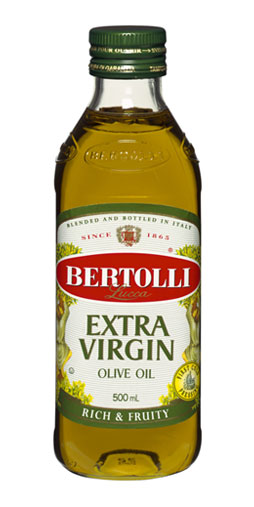
We are currently buying the 1 litre glass bottle of Bertolli EVOO.
Glass is better for the environment, I think – it’s made of sand, silica and limestone and while it doesn’t biodegrade easily, it can be recycled over and over again, forever. I’ve also seen pieces of glass at the beach, all smooth and no longer resembling whatever they originally were. It takes way less energy to produce (especially if it’s recycled) and if it gets dumped, you know it’s not going to leach toxins or hurt an animal (unless it’s broken and they get cut). The eco-downside is that because it’s heavier, it takes more energy to ship, and it can break more easily during shipping, causing greater waste. Apparently it takes more energy to recycle than plastic too, but I think maybe that’s not considering fancy glass recycling plants like the Visy plant in Melbourne.
Plastic is made from petrochemicals and doesn’t biodegrade. It’s made of all kinds of nasty toxic stuff and hangs around killing animals for ages. Production almost always includes nurdles as a by-product, and let’s not even talk about the floating plastic continent of doom. It’s lighter and more durable and consumes less energy when shipping though.
I’m inclined to go for glass, but if we buy glass, it comes in a smaller package, which means more packaging to get the same amount of oil. I think they sell it in a 5 litre tin too, but our tiny house is not made for storing significant bulk food purchases, as much as I like the idea, so that won’t work for us.
Which one should we buy?
We have a lot of glass jars. Like, a lot. Half a cabinet full. We haven’t thrown any glass jars out for about 18 months. Based on the fact that we use maybe one glass jar a week (pasta sauce, curry sauce, salsa etc), I think we’d have at least 52 jars sitting around the kitchen. That’s a pretty conservative estimate – there are probably more!

We use empty pasta sauce jars to store dried fruit, mushrooms and nuts.
So why do we keep them? Mostly because they’re such handy containers, and because we can’t bring ourselves to recycle them when there’s so many things they can be used for. You see, recycling is the third R for a reason – reduce and reuse come before it. You should only do it if you couldn’t manage without something (that is, couldn’t reduce) and once you’ve used it, you find yourself unable to reuse it anymore. Recycling (while better than landfills or creating new things) is energy intensive, creates pollution, and not everything can even be recycled. I’m not saying recycling is bad – it’s not – but it’s also not ideal.
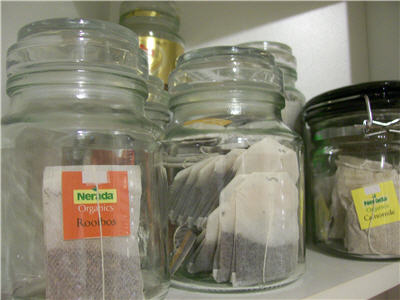
We got these empty coffee jars on Freecycle and use them to store our tea
So we keep trying to reuse things as long and as much as we can. Especially jars, it seems. We even get all categorical and use particular jars for particular things. We use jars for:
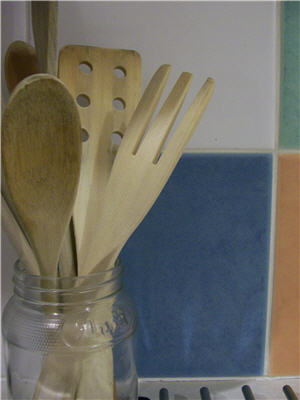
We store wooden kitchen utensils in empty Marshmallow Fluff jars
Essentially, we use jars wherever we can. And we still have half a cupboard of empty ones. So what are we going to use those for? Any ideas? Anyone need a jar or two?
Or eighty?